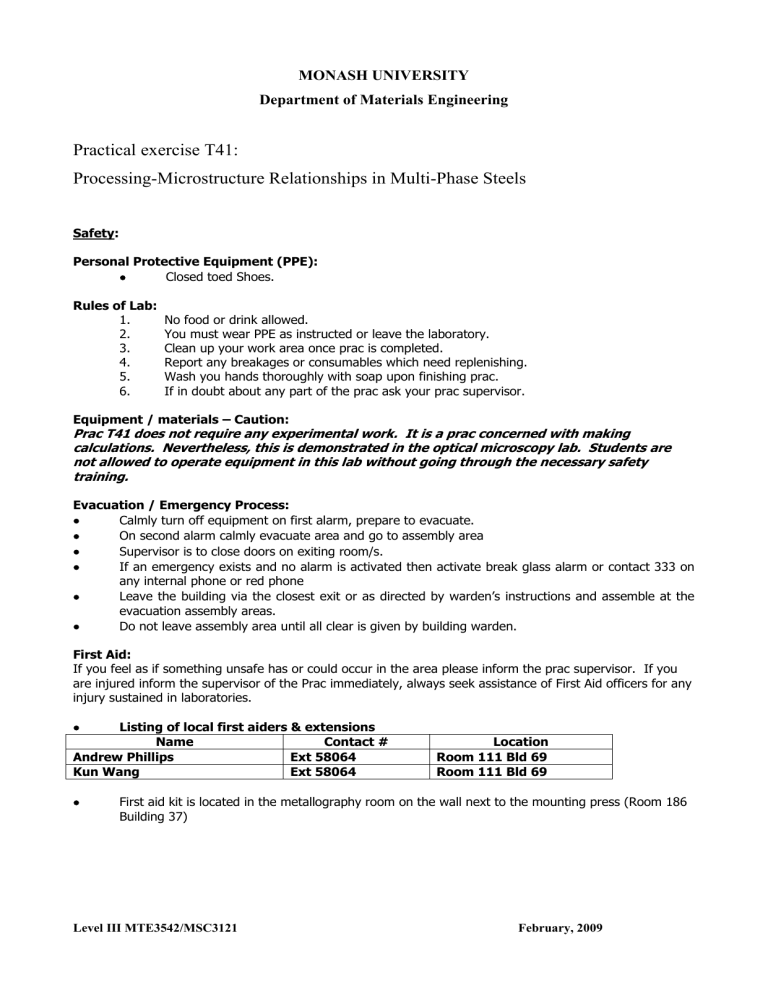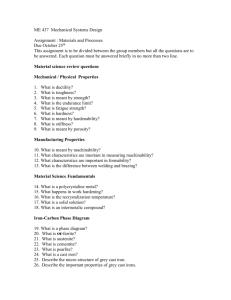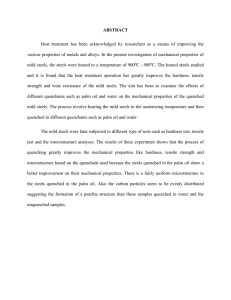Practical exercise T41: Processing

MONASH UNIVERSITY
Department of Materials Engineering
Practical exercise T41:
Processing-Microstructure Relationships in Multi-Phase Steels
Safety:
Personal Protective Equipment (PPE):
•
Rules of Lab:
1.
2.
3.
4.
5.
6.
Closed toed Shoes.
No food or drink allowed.
You must wear PPE as instructed or leave the laboratory.
Clean up your work area once prac is completed.
Report any breakages or consumables which need replenishing.
Wash you hands thoroughly with soap upon finishing prac.
If in doubt about any part of the prac ask your prac supervisor.
Equipment / materials – Caution:
Prac T41 does not require any experimental work. It is a prac concerned with making calculations. Nevertheless, this is demonstrated in the optical microscopy lab. Students are not allowed to operate equipment in this lab without going through the necessary safety training.
Evacuation / Emergency Process:
•
•
•
•
Calmly turn off equipment on first alarm, prepare to evacuate.
On second alarm calmly evacuate area and go to assembly area
Supervisor is to close doors on exiting room/s.
If an emergency exists and no alarm is activated then activate break glass alarm or contact 333 on any internal phone or red phone
• Leave the building via the closest exit or as directed by warden’s instructions and assemble at the evacuation assembly areas.
• Do not leave assembly area until all clear is given by building warden.
First Aid:
If you feel as if something unsafe has or could occur in the area please inform the prac supervisor. If you are injured inform the supervisor of the Prac immediately, always seek assistance of First Aid officers for any injury sustained in laboratories.
• Listing of local first aiders & extensions
Andrew Phillips
Kun Wang
•
Ext 58064
Ext 58064
Room 111 Bld 69
Room 111 Bld 69
First aid kit is located in the metallography room on the wall next to the mounting press (Room 186
Building 37)
Level III MTE3542/MSC3121 February, 2009
INTRODUCTION
Steels are by far the most commonly used metallic materials. One reason is that they are relatively cheap. Another reason is that the diversity of microstructures that can be formed in steels translates to a very large variety in achievable mechanical properties and therefore a large range of possible applications. This variety in microstructure arises from the response of steels to thermo-mechanical processing (temperature and deformation) and the richness in the variety of phase transformations that occur in steels. Each of the phase transformations that occur in other materials can all be found in steels, and often within the same steel composition.
An extremely important class of steels is the Multi-phase steels. As the name suggests, these are steels that contain a variety of different phases, and importantly, these different phases have very different mechanical properties. Multi-phase steels are usually designed for use in applications requiring both high strength and high elongation and are often referred to as Advanced High
Strength Steels (AHSS). A plot illustrating the strength-elongation combinations of the most commonly used steels is shown below in Fig. 1.
Figure 1. Strength-Elongation combinations of the most commonly used steels (courtesy O. Bouaziz (ARCELOR
Research)). IF (Interstitial free), HSLA (High Strength Low Alloy), DP (Dual Phase), TRIP (Transformation
Induced Plasticity).
AHSS are particularly popular with the automotive industry where they find many uses including, panels of automobiles. Figure 2 below illustrates the views of General Motors (GM) and Daimler-
Chrysler on the uses of the different types of steels in the future.
Level III MTE3542/MSC3121 February, 2009
Figure 2. GM and Daimler Chrysler outlooks on the future uses of steels in the automobile industry.
As can be seen, AHSS such as DP and TRIP steels are expected to account for >40% of all steels used in the automobile industry. The reason is that these two types of steels have perhaps the best combinations of strength and elongation. In this practical exercise we will examine the formation of the microstructures of the DP and TRIP steels, i.e. the relationship between processing and microstructure. In the companion practical exercise (T42) we will consider the relationship between the microstructures of DP and TRIP steels and the mechanical properties which are observed.
EXPERIMENTAL PROCEDURE
Part A. Microstructure of DP steel
Typical optical micrographs of a DP steel are shown in Fig. 3 below.
M
F
Figure 3. Low and high magnification optical microscopy images of a Dual Phase (DP) Steel. The dark regions are martensite (M) and the light regions are ferrite (F).
The composition of a typical DP steel is shown in Table 1.
Level III MTE3542/MSC3121 February, 2009
Table 1. Composition of steels (wt. %)
DP (IA)
TRIP (IA)
0.036
0.12
1.065 1.08
1.77 1.39
0.018 0.004 0.083
0.031 0.005 0.02
Q1. Using the phase diagram below (which applies to this DP steel) describe the thermal processing needed to form DP (ferrite + martensite) microstructures containing 10%, 20%, 30% and
40% martensite. What are the corresponding C contents of the martensite? What is the maximum
C content that can be achieved in the martensite? How much martensite can be formed with this maximum C content?
Figure 4. Phase diagram relevant to the DP steel discussed above.
Level III MTE3542/MSC3121 February, 2009
Upon forming martensite in DP steels, we often observe a large increase in the dislocation density in the ferrite. An example TEM micrograph is shown in Fig.4.
Fig. 4. TEM micrograph of the microstructure of DP steel. M
PF is martensite and PF and F are ferrite. Circular line shows the region with increased dislocation density.
M
Q2. Explain why an increase in the local dislocation density is observed in the ferrite in these DP structures?
The formation of martensite in DP steels relies on the ability to suppress other competing phase transformations such as pearlite and bainite. To help martensite formation Mn and Si are usually added to these steels. Mn and Si both retard the formation of pearlite and affect the martensite start temperature. The martensite transformation temperature can be calculated using the following empirical equation:
M s
( o
C) = 539 - 423(wt%C) – 30.4(wt%Mn) – 17.7(wt%Ni) – 12.1(%Cr) – 7.5(wt%Mo)
Q3. For the composition of the DP phase in Table 1, calculate the martensite start temperature for treatments corresponding to 10%, 20%, 30% and 40% martensite.
Part B. Microstructure of TRansformation Induced Plasticity Steel (TRIP)
The microstructures of TRIP steels are more complicated than those of DP steels. TRIP steels are popular because they have even better elongation than DP steels without sacrificing strength. The main phenomenon responsible for the improved elongation has been proposed to be the deformation-induced transformation of the metastable austenite, formed in the microstructure after processing, to martensite during straining. This strain-induced transformation is very sensitive to the C content of the retained austenite. One type of TRIP steel is known as the Intercritical
Annealed (IA) TRIP steel. The alloys are annealed first in the austenite+ferrite two phase field and are then given a second annealing treatment in the ferrite+cementite two phase field. This is schematically illustrated in Fig. 5. below.
Level III MTE3542/MSC3121 February, 2009
Figure 5. Schematic illustration of the two annealing treatments used in the processing of TRIP steels.
The first of these anneals is very similar to the treatment given to the DP steels. However, the microstructure of IA TRIP steels consists not of ferrite and martensite but of ferrite, bainite and retained austenite. An example micrograph is shown below in Figure 6.
Figure 6. Optical micrographs of an IA TRIP Steel
Q4. A key difference between DP and TRIP steels is that TRIP steels contain retained metastable austenite at room temperature which can transform to martensite when deformed (strain-induced transformation). Explain why it is necessary for TRIP steels to have an additional annealing treatment within the ferrite+cemenite two phase field? Use the phase diagram shown in Figure 4.
Hint: Si is added to TRIP steels because it retards the formation of Fe
3
C.
Level III MTE3542/MSC3121 February, 2009
ASSESSMENT
Write a brief report answering each of the 5 questions above. Explain your reasoning.
All assignments and laboratory reports will need to be submitted with a bar-coded coversheet.
The coversheet is accessible via the Monash portal page located at http://my.monash.edu.au
under the heading “Learning and teaching tools.”
All assignments should be submitted using the level 3 letter box (M3) located in Building 19 opposite the Materials Engineering General Office (Room 143F)
Level III MTE3542/MSC3121 February, 2009



